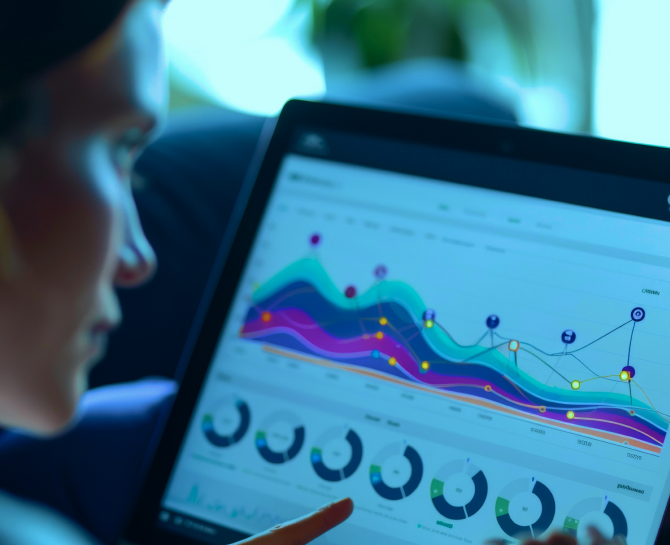
The Strategic Value of AI-Driven Data Analysis in Google Analytics for B2B Brands
This article examines how AI-driven data analysis in Google Analytics is transforming B2B marketing, from identifying high-intent behaviors and real-time anomalies to enhancing event-based tracking and attribution. If your brand relies on data but struggles to act on it quickly, this guide shows how AI bridges that critical gap.
What if your marketing data could not only explain the past but also anticipate the future?
Data is abundant but insights are often scarce. Marketers are constantly overwhelmed by dashboards, reports, and fragmented customer journeys. The problem is not a lack of information but the inability to interpret it quickly and accurately enough to guide decisions that matter.
This is where AI-driven data analysis in Google Analytics offers real value. It shifts the role of analytics from reactive reporting to proactive strategy. By combining automation, predictive metrics, and machine learning, B2B teams can now identify trends faster, understand buyer intent in real time, and optimize performance with a level of precision that manual analysis simply cannot deliver.
This blog explores how AI-driven capabilities in Google Analytics are transforming how B2B brands operate, analyze, and compete in data-centric environments.
What Is AI-Driven Data Analysis in Google Analytics?
At its core, AI-driven data analysis in Google Analytics refers to the use of machine learning models to automatically detect patterns, predict outcomes, and generate actionable insights from user behavior data, without requiring constant manual intervention. Google Analytics 4 (GA4) is designed with AI and machine learning at its foundation. Unlike Universal Analytics, which focused on descriptive reporting, GA4 uses predictive analytics to help teams interpret data, understand intent, and prioritize action.
Addressing the Decision-Making Lag in B2B Marketing Analytics
In B2B marketing, the gap between data collection and actionable insight often delays critical decisions. Sales cycles are long, buyer journeys are non-linear, and multiple stakeholders influence every conversion. Traditional analytics tools may capture this complexity, but they rarely translate it into timely, usable guidance.
This is where AI-driven data analysis in Google Analytics brings measurable value. Rather than requiring manual interpretation of multi-channel data, GA4’s AI capabilities identify meaningful changes and trends in real time.
More importantly, AI compresses the time it takes to move from signal to strategy. Predictive metrics such as purchase probability and churn likelihood empower teams to act before a lead cools or an opportunity is lost. This is especially valuable in B2B scenarios where delayed responses can affect deal velocity or lead quality.
For marketing and revenue leaders, this means fewer missed windows, faster course correction, and better alignment between campaign execution and business goals. By reducing the lag between observation and decision, AI not only improves operational efficiency but also enhances competitive responsiveness in markets where timing is everything.
Solving the Multi-Touch Attribution Problem in B2B
B2B customer journeys are rarely linear. A prospect may engage with content across multiple platforms over weeks or months before converting. Linear attribution assigns equal weight to all touchpoints, ignoring the context, sequence, or intent behind each interaction. This oversimplifies complex buying behavior and limits marketers’ ability to understand true conversion drivers.
How AI Surfaces Hidden Conversion Paths
- Dynamic Weighting of Touchpoints: AI in Google Analytics evaluates each interaction based on actual influence, not just position. This allows it to prioritize high-impact touchpoints, such as product comparisons or pricing page visits, over less meaningful actions like homepage views.
- Pattern Recognition Across Sessions: Instead of evaluating sessions in isolation, AI connects behavioral signals across time. For example, it might identify that returning visitors who engage with solution briefs after a LinkedIn ad are far more likely to convert than those who do not revisit at all.
- Detection of Assistive Channels: AI uncovers channels that may not lead directly to conversion but contribute consistently throughout the journey. Channels like webinars or industry reports often play this role in B2B, and AI highlights their influence even when they do not close deals.
- Contextual Analysis of Timing and Sequence: AI analyzes when touchpoints occur and how they are sequenced. This helps identify whether early-stage content is actually creating momentum or if engagement is stalling before decision-making touchpoints.
- Automatic Highlighting of Anomalies and Trends: Google Analytics uses anomaly detection to flag when a particular path or behavior deviates significantly from the norm. This could include sudden spikes in engagement from specific segments or a drop in previously strong conversion paths, helping teams adjust strategy quickly.
Pro Tip- AI insights can help isolate content and channels accelerate deal progression. Use this intelligence to re-prioritize nurture journeys, serving influential assets earlier and tailoring messages based on historical conversion patterns. This reduces drop-off and improves pipeline velocity.
Underused But Powerful Features B2B Teams Should Know
1. Predictive Audiences
Identify users likely to convert, churn, or take a specific action based on behavioral signals. This enables B2B marketers to target high-intent segments earlier in the funnel with tailored content and reduce wasted ad spend on low-quality traffic.
2. AI-Powered Anomaly Detection
GA4 automatically flags unusual changes in user behavior, conversions, or channel performance. These alerts allow B2B teams to react quickly to drops or spikes in performance, even across long and complex campaigns.
3. Custom Funnel Explorations
Move beyond basic funnel reports by creating dynamic, stage-specific funnels. GA4 helps identify exact points of drop-off and enables pattern analysis, giving you visibility into how different audiences navigate key decision paths.
4. Predictive Metrics
Use forecasts like purchase probability and revenue prediction to inform campaign targeting and budget allocation. For B2B businesses, this means focusing resources on leads that are more likely to move deeper into the sales pipeline.
5. Enhanced Audience Triggers
Set automated actions based on real-time audience behavior. For example, trigger remarketing or email sequences when a user completes a key action like viewing multiple product pages or spending a threshold amount of time on high-value content.
How AI Enhances Event-Based Tracking in GA4
Google Analytics 4 replaces the traditional session-based model with a more flexible event-based structure. Every interaction, whether it is a page view, video play, form submission, or scroll, is now treated as a discrete event. This change unlocks new opportunities for AI to deliver nuanced, actionable insights across the entire B2B buyer journey.
AI-driven data analysis leverages granular event data to uncover behavioral patterns that span channels, visits, and devices. It does not just count what happened. It interprets how and why users engage the way they do, especially across complex, non-linear buying journeys that are typical in B2B.
Why Event-Based Tracking Improves AI Interpretation
Event-based tracking provides richer, structured data for machine learning models. This allows AI to:
- Understand micro-conversions and subtle signals of intent.
- Analyze sequences of actions, not just single outcomes.
- Correlate engagement patterns with long-term revenue behavior.
The result is a deeper understanding of the digital body language that precedes meaningful business outcomes.
B2B-Specific Applications in GA4
- Identify High-Intent Sequences: AI in GA4 can recognize that users who download a pricing sheet, return via a branded search ad, and then view a demo page within 48 hours are significantly more likely to convert. These sequences become new micro-funnel signals that marketing and sales can act on.
- Detect Engagement Drop-Offs by Segment: If form submissions from a specific industry or company size decline, AI highlights this trend based on historical event activity, allowing you to re-engage the segment before interest fades.
- Improve Multi-Asset Nurturing: This helps tailor content journeys that match how high value leads naturally interact.
Key Takeaways
- AI in GA4 allows B2B marketers to shift from reactive analysis to proactive decision-making by surfacing real-time, actionable insights.
- Event-based tracking in GA4 gives AI the depth and granularity to understand non-linear B2B buyer journeys across platforms and channels.
- Predictive metrics such as purchase probability and churn likelihood help teams prioritize efforts before opportunities are lost.
- AI-powered attribution models in GA4 reveal which channels and touchpoints truly influence conversion, improving strategy and budget allocation.
- Underused features like predictive audiences, anomaly detection, and enhanced audience triggers offer B2B teams faster paths to performance optimization.
Conclusion
AI-driven data analysis in Google Analytics is not just an enhancement, it is a strategic enabler for B2B brands navigating complex digital ecosystems. As customer journeys grow more fragmented and decision cycles lengthen, the ability to interpret data patterns in real time becomes critical. GA4, with its built-in AI capabilities, provides that advantage.
Instead of overwhelming teams with raw numbers, it translates data into insight, highlights what matters most, and even suggests next actions. For B2B organizations where timing, targeting, and trust all matter, this means faster pivots, smarter segmentation, and stronger ROI from every campaign touchpoint.
Are you ready to turn your marketing data into your next competitive milestone? Let us talk!
Our experts at DiGGrowth can help you implement, refine, and operationalize AI-driven analytics strategies that accelerate your revenue engine. Reach out to us at info@diggrowth.com to learn more and get started right away.
Ready to get started?
Increase your marketing ROI by 30% with custom dashboards & reports that present a clear picture of marketing effectiveness
Start Free Trial
Experience Premium Marketing Analytics At Budget-Friendly Pricing.

Learn how you can accurately measure return on marketing investment.
Additional Resources
How Predictive AI Will Transform Paid Media Strategy in 2026
Paid media isn’t a channel game anymore, it’s...
Read full post postDon’t Let AI Break Your Brand: What Every CMO Should Know
AI isn’t just another marketing tool. It’s changing...
Read full post postFrom Demos to Deployment: Why MCP Is the Foundation of Agentic AI
A quiet revolution is unfolding in AI. And...
Read full post postFAQ's
Yes, AI in GA4 can analyze engagement metrics across content assets and flag those with declining interaction, high bounce rates, or poor conversion impact. This allows B2B teams to refine or retire content that no longer aligns with audience interest or funnel progression.
GA4’s predictive capabilities analyze historical engagement and conversion trends to forecast how future campaigns may perform. This includes estimating likely outcomes for audience segments, helping marketers allocate budgets more effectively and set realistic performance expectations before launch.
Yes, AI models in GA4 analyze behavior patterns such as repeated visits, content depth, and time on site to infer intent, even from users who have not identified themselves. These signals support smarter retargeting and nurture flows, especially in early-stage B2B engagement.
By surfacing automated insights and anomalies, AI reduces the time spent generating manual reports. It helps teams quickly understand what changed, why it matters, and where to take action, without waiting for scheduled dashboards or weekly performance reviews.
Absolutely. AI can detect patterns in user drop-off or low engagement on specific landing pages. It identifies which page elements correlate with poor performance, helping marketers test variations, streamline content, and increase relevance for specific B2B segments.


